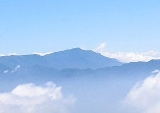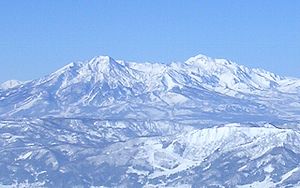
Mount Myoko
Encyclopedia
is an active stratovolcano
in Honshū
-island, Japan
. It is situated at the southwest of Myōkō city, Niigata Prefecture
, and a part of Joshinetsu Kogen National Park
. Mount Myōkō is listed as one of 100 Famous Japanese Mountains, and together with , it is well known as the "famous mountain" of Niigata Prefecture.
, it is linked to those on the Nagano side as one of the . The mountain was originally named but was later changed to . This can be also written as 妙高山, in order to make use of two "lucky" characters.
, andesite
, and dacite
. Its maximum height is estimated to have been between 2800 metres (9,186.4 ft) and 2900 metres (9,514.4 ft), but it presently reaches only 2454 metres (8,051 ft). Around 19,000 years ago, the top was blown off in a major eruption, forming a 3 km (2 mi) wide caldera
. About 6,000 years ago, the central crater developed and assumed its present shape. A lava dome
forms the volcano's present summit. The most recent eruptions about 4,300 years ago produced pyoclastic flows down the eastern flanks. Present activity is solfataric from fumarole
s near the lava dome, where sulfur
was once mined.
There are onsen
and ski resort
s at the foot of the mountain, including Akakura, Suginohara and Ikenotaira.

Myōkō
of the Imperial Japanese Navy
and an Aegis
destroyer
of the Japan Maritime Self-Defense Force
are named after this mountain.
The mountain appears invariably in school songs of elementary and middle schools in the Joetsu Region
.
In 1990 the Nippon Jamboree
, a camping festival, was held on the during which the participants climbed the mountain.
Stratovolcano
A stratovolcano, also known as a composite volcano, is a tall, conical volcano built up by many layers of hardened lava, tephra, pumice, and volcanic ash. Unlike shield volcanoes, stratovolcanoes are characterized by a steep profile and periodic, explosive eruptions...
in Honshū
Honshu
is the largest island of Japan. The nation's main island, it is south of Hokkaido across the Tsugaru Strait, north of Shikoku across the Inland Sea, and northeast of Kyushu across the Kanmon Strait...
-island, Japan
Japan
Japan is an island nation in East Asia. Located in the Pacific Ocean, it lies to the east of the Sea of Japan, China, North Korea, South Korea and Russia, stretching from the Sea of Okhotsk in the north to the East China Sea and Taiwan in the south...
. It is situated at the southwest of Myōkō city, Niigata Prefecture
Niigata Prefecture
is a prefecture of Japan located on the island of Honshū on the coast of the Sea of Japan. The capital is the city of Niigata. The name "Niigata" literally means "new lagoon".- History :...
, and a part of Joshinetsu Kogen National Park
Joshinetsu Kogen National Park
is a national park in the Chubu region, Honshū, Japan. It is divided into two separate areas: the Southern Niigata/North Nagano Area and the East Nagano Area....
. Mount Myōkō is listed as one of 100 Famous Japanese Mountains, and together with , it is well known as the "famous mountain" of Niigata Prefecture.
Name
is another name given to this mountain. Being close to the border with Nagano PrefectureNagano Prefecture
is a prefecture of Japan located in the Chūbu region of the island of Honshū. The capital is the city of Nagano.- History :Nagano was formerly known as the province of Shinano...
, it is linked to those on the Nagano side as one of the . The mountain was originally named but was later changed to . This can be also written as 妙高山, in order to make use of two "lucky" characters.
Geology and geography
Mount Myōkō was formed beginning about 300,000 years ago, in a series of eruptions producing a broad spectrum of lava types including basaltBasalt
Basalt is a common extrusive volcanic rock. It is usually grey to black and fine-grained due to rapid cooling of lava at the surface of a planet. It may be porphyritic containing larger crystals in a fine matrix, or vesicular, or frothy scoria. Unweathered basalt is black or grey...
, andesite
Andesite
Andesite is an extrusive igneous, volcanic rock, of intermediate composition, with aphanitic to porphyritic texture. In a general sense, it is the intermediate type between basalt and dacite. The mineral assemblage is typically dominated by plagioclase plus pyroxene and/or hornblende. Magnetite,...
, and dacite
Dacite
Dacite is an igneous, volcanic rock. It has an aphanitic to porphyritic texture and is intermediate in composition between andesite and rhyolite. The relative proportions of feldspars and quartz in dacite, and in many other volcanic rocks, are illustrated in the QAPF diagram...
. Its maximum height is estimated to have been between 2800 metres (9,186.4 ft) and 2900 metres (9,514.4 ft), but it presently reaches only 2454 metres (8,051 ft). Around 19,000 years ago, the top was blown off in a major eruption, forming a 3 km (2 mi) wide caldera
Caldera
A caldera is a cauldron-like volcanic feature usually formed by the collapse of land following a volcanic eruption, such as the one at Yellowstone National Park in the US. They are sometimes confused with volcanic craters...
. About 6,000 years ago, the central crater developed and assumed its present shape. A lava dome
Lava dome
|250px|thumb|right|Image of the [[rhyolitic]] lava dome of [[Chaitén Volcano]] during its 2008–2009 eruption.In volcanology, a lava dome is a roughly circular mound-shaped protrusion resulting from the slow extrusion of viscous lava from a volcano...
forms the volcano's present summit. The most recent eruptions about 4,300 years ago produced pyoclastic flows down the eastern flanks. Present activity is solfataric from fumarole
Fumarole
A fumarole is an opening in a planet's crust, often in the neighborhood of volcanoes, which emits steam and gases such as carbon dioxide, sulfur dioxide, hydrochloric acid, and hydrogen sulfide. The steam is created when superheated water turns to steam as its pressure drops when it emerges from...
s near the lava dome, where sulfur
Sulfur
Sulfur or sulphur is the chemical element with atomic number 16. In the periodic table it is represented by the symbol S. It is an abundant, multivalent non-metal. Under normal conditions, sulfur atoms form cyclic octatomic molecules with chemical formula S8. Elemental sulfur is a bright yellow...
was once mined.
There are onsen
Onsen
An is a term for hot springs in the Japanese language, though the term is often used to describe the bathing facilities and inns around the hot springs. As a volcanically active country, Japan has thousands of onsen scattered along its length and breadth...
and ski resort
Ski resort
A ski resort is a resort developed for skiing and other winter sports. In Europe a ski resort is a town or village in a ski area - a mountainous area, where there are ski trails and supporting services such as hotels and other accommodation, restaurants, equipment rental and a ski lift system...
s at the foot of the mountain, including Akakura, Suginohara and Ikenotaira.

Related Facts
The heavy cruiserHeavy cruiser
The heavy cruiser was a type of cruiser, a naval warship designed for long range, high speed and an armament of naval guns roughly 203mm calibre . The heavy cruiser can be seen as a lineage of ship design from 1915 until 1945, although the term 'heavy cruiser' only came into formal use in 1930...
Myōkō
Japanese cruiser Myoko
was the name-ship of the four-member of heavy cruisers of the Imperial Japanese Navy — the other ships of the class being the Nachi, Ashigara, and Haguro....
of the Imperial Japanese Navy
Imperial Japanese Navy
The Imperial Japanese Navy was the navy of the Empire of Japan from 1869 until 1947, when it was dissolved following Japan's constitutional renunciation of the use of force as a means of settling international disputes...
and an Aegis
Aegis combat system
The Aegis Combat System is an integrated naval weapons system developed by the Missile and Surface Radar Division of RCA, and now produced by Lockheed Martin...
destroyer
Kongo class destroyer
The of guided missile destroyers serves as the core ship of the Japan Maritime Self-Defense Force 's Escort Flotillas. They are a modification of the United States Navy's Arleigh Burke class .-Design:...
of the Japan Maritime Self-Defense Force
Japan Maritime Self-Defense Force
The , or JMSDF, is the naval branch of the Japan Self-Defense Forces, tasked with the naval defense of Japan. It was formed following the dissolution of the Imperial Japanese Navy after World War II....
are named after this mountain.
The mountain appears invariably in school songs of elementary and middle schools in the Joetsu Region
Joetsu, Niigata
is a city located in Niigata Prefecture, Japan.As of June 1, 2011, the city has an estimated population of 205,521, with 72,982 households and a population density of 211.15 persons per km². The total area is 973.32 km²....
.
In 1990 the Nippon Jamboree
Nippon Jamboree
The is a camping festival held by the Scout Association of Japan, and is the largest Scouting event in Japan.Jamborees are held once every four years, and are abbreviated as "NJ", or including the number of the event, as 14NJ for the 14th Nippon Jamboree.- Locations:* 1st Nippon Jamboree August 2...
, a camping festival, was held on the during which the participants climbed the mountain.
External links
- Myōkō City official website
- Topographic map (1:25,000)

